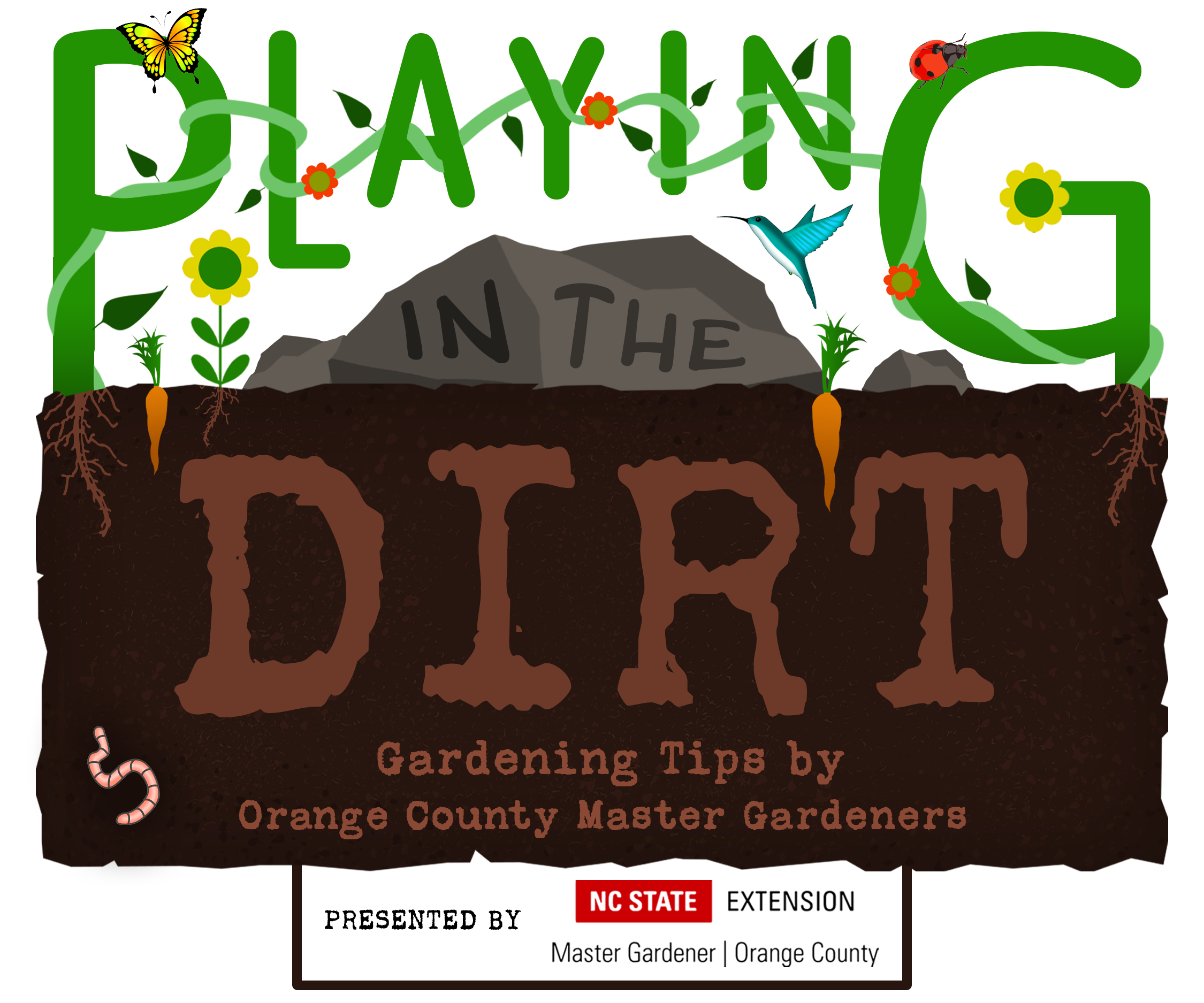
97.9 The Hill and Chapelboro.com have partnered with NC State Extension Master Gardener℠ volunteers of Orange County for “Playing in the Dirt,” a monthly column providing information and inspiration to gardeners of all skill levels! Check back on Chapelboro each month for a new subject – from our gardens to yours!
By MaryLou Gelblum, Orange County Master Gardener℠ volunteers
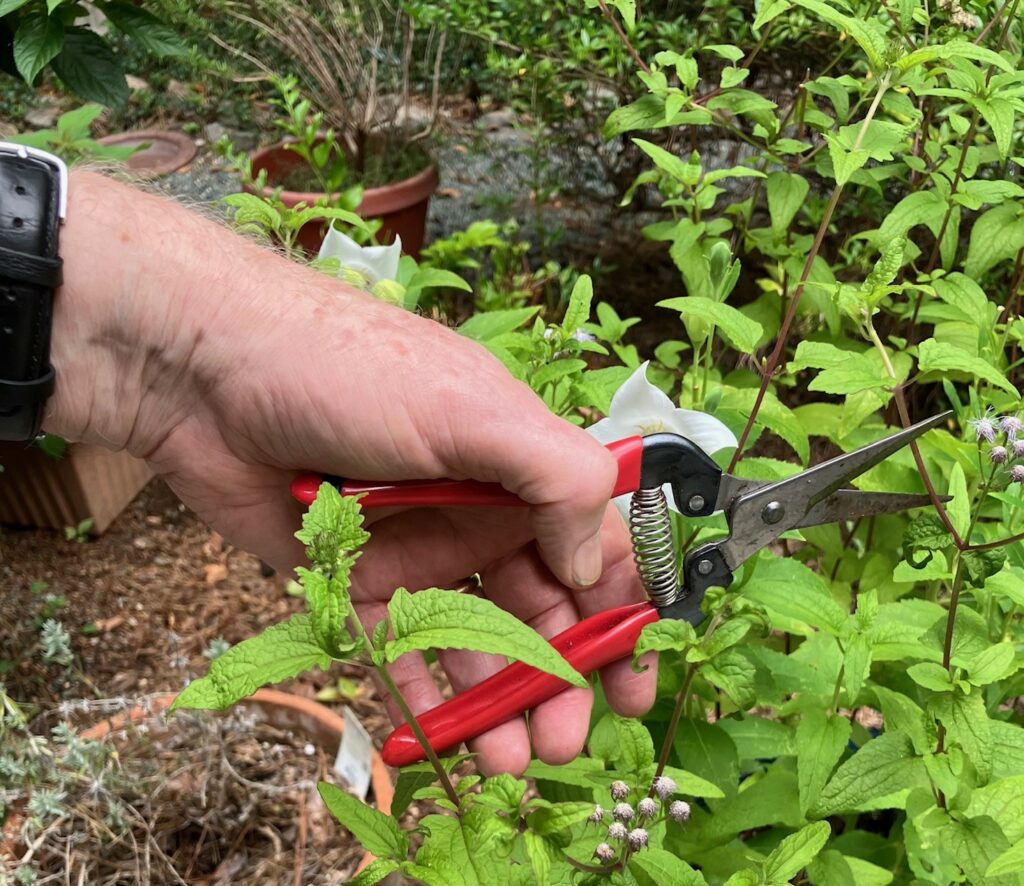
Using snips, a bypass pruner, for precise, clean cuts. (Photo: Margaret Cloud.)
For people who garden, probably our most go-to tool is our secateurs, commonly called one-handed pruning shears or just “hand pruners.” Whether we are deadheading, snipping flowers, or clipping branches of up to about 1/2 inch in diameter, secateurs are what we grab. Because of their importance, we’ll review the options, their uses, and what to consider when buying.
The Bypass
Bypass hand pruners can be compared to scissors for outdoor use, with two sharpened blades that pass over each other to make clean precise cuts. The bypass blades may be curved, straight, or small. These are the most commonly used hand pruners, are ideal when making thin fine cuts, and can be used on soft branches, herbs, and flowers. Small, pocket-sized gardening snips with thin, pointed blades are handy for precise, close-up work like clipping herbs and deadheading flowers.
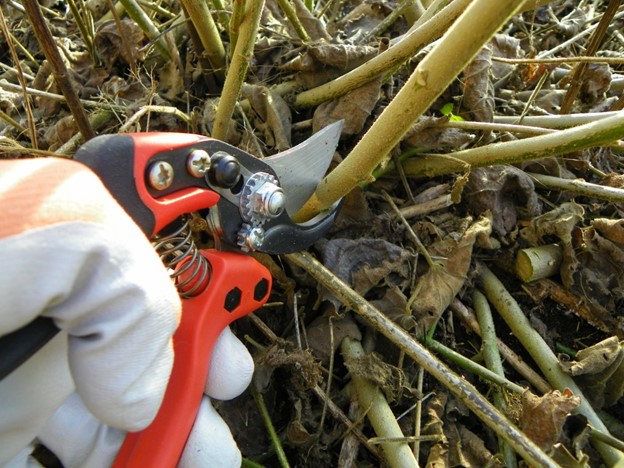
Cutting dead perennial stems before spring growth with a bypass pruner. (Photo: Charlotte Glen, NC State Extension.)
The Anvil
The anvil type of hand pruner has a double edge sharp blade (curved or straight) that presses onto a base plate or block (anvil), essentially smashing and pushing through thicker dry woody stems. Its cut is not as close as that of the bypass, but it is more powerful and requires less physical effort. Because the anvil tends to crush stems, many gardeners do not recommend their use and prefer a bypass pruner for green wood. Anvils are fine for dead wood.
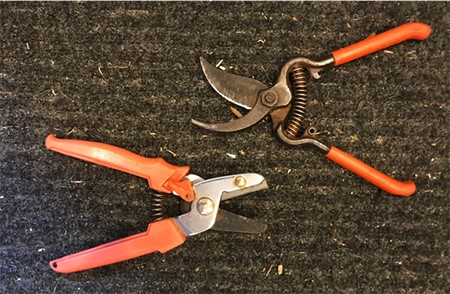
Anvil pruners with straight blade (lower left) and bypass pruners (upper right). (Photo: Barbara Fair, NC Cooperative Extension.)
The Ratchet
Ratchet secateurs have either bypass or anvil blades and include a mechanism that allows you to cut in multiple steps with a press, release, repeat action. This improves leverage and can be the best choice for hands that are small or not as strong.
What to Consider When Purchasing
The choices of secateurs can be overwhelming, with multiple sizes, types, metals, colors, and prices readily available. As important as these tools are in our lives, it is worth taking time to consider a number of factors before purchasing.
- Comfort. Hold the tool with and without gloves. Some have easy-grip rubberized handles; some are hard plastic. Some have curved handles; others narrow and straight. Try the blade locking mechanism, the spring action, and the grip. Do you like the weight or does it feel too light or heavy? If you tend to garden for several hours, it needs to be comfortable to hold and use.
- The metal and quality of the blades. Many gardeners prefer hardened high-carbon steel blades, which are tough and last longer. These rust faster though, requiring more upkeep. Check to see if they have a non-stick coating, which helps with cleanup. There are also good stainless steel blade options that don’t rust as quickly but also are not as tough. These blades can be good for snips and small work and generally cost less.
- Types of tasks. How do you spend your time in the garden? If you love to tackle branches, you will need durable anvil or ratchet hand pruners. If you are more likely to prune flowers and shrubs with small branches, bypass will be the best choice. One thing to keep in mind is to use the correct secateurs for the task at hand. Do not push them to do work they were not made to do — the pruners will be damaged or your plant will be injured with a jagged cut As cautioned in this NC State Extension article, “No matter the type of hand pruners you choose, never cut a stem too big for your tools. You will know this is happening if you have to squeeze too tightly to make the cut. Not only will you damage the tissue of the plant, but you may damage your pruners.”
- Price. Like most products, if you want your secateurs to perform well and last for many years, you will need to spend more for higher quality. However, caring for your pruners is important. This includes cleaning, drying, oiling, and sharpening often — not once a year or never. If you are one who tends to use a tool and store it until it no longer works, a series of cheaper models may work just fine.
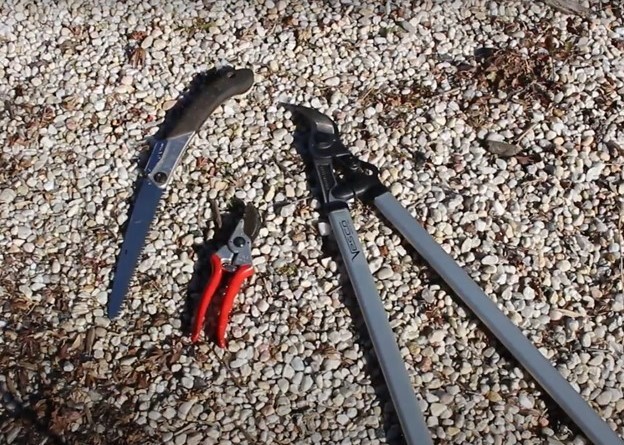
Essential tools: (left to right) hand pruner, loppers, pruning saw. (Photo: Hannah Lepsch, HorticultureMountain Hort Crops Research & Extension Center, NC State Extension.)
Larger Branches
Generally, the appropriate tools for pruning branches larger than 1/2 inch include lopping shears, pruning saws, hedge shears, and chain saws.
You can use lopping shears, sometimes called loppers or secateurs, for branches up to 1 1/2 inch in diameter. These have blades attached to long handles (telescoping handles are an option), are available in bypass and anvil styles, and may have a ratcheting mechanism similar to hand pruners. The longer handles provide greater leverage for cutting through larger branches and the ability to prune in harder to reach areas. Some gardeners recommend only using loppers to cut dead wood or reduce the size of branches on the ground. They feel that loppers are often misused by gardeners to cut live wood too wide in diameter thereby damaging the plant with a ragged cut that doesn’t heal properly.
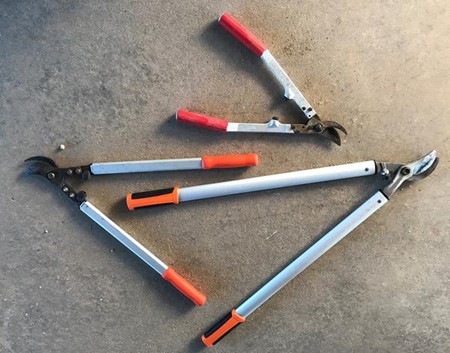
Bypass loppers of different lengths. (Photo: Barbara Fair, NC Cooperative Extension.)
Various types of pruning saws — including hand saws and pole saws — are commonly used for pruning branches larger than 1 1/2 inches. Manual or powered hedge shears are designed for making clean, straight cuts to multiple branches at a time to shape formal hedges but are not for pruning individual branches. Chain saws, which are quite dangerous, are used for cutting very large branches but should only be used with safety equipment by trained and experienced gardeners or arborists.
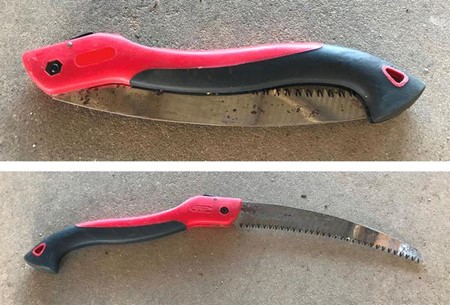
Example of a handsaw for pruning. This one conveniently folds up! (Photo: Barbara Fair, NC Cooperative Extension.)
Enjoying time in the garden is certainly enhanced by having the right tool for the task. We all should aspire to having a basket full of beautiful, handy secateurs. The resources below offer additional guidance on selecting and maintaining the right pruning tool.
Read More:
- Tools to Make the Cut: Pruning Trees and Shrubs, NC Cooperative Extension.
- (Other publications in the “Pruning Trees and Shrubs” series: Before the Cut; General Pruning Techniques; How to Prune Specific Plants)
- The Basics of Pruning Tools, Nebraska Extension
- Pruning Equipment for Home Gardeners (pdf to download), Washington State University Extension
- See June 2024 Playing in the Dirt for resources on cleaning and sharpening garden tools
- These videos provide information on selecting and caring for pruning tools:
- Selecting Pruning Tools, Tom Gale, NC Cooperative Extension
- Sharpening and Caring for Your Pruning Tools, Tom Gale, NC Cooperative Extension
- Tree Pruning Video Series, Dr. Barbara Fair, NC State Horticulture
More from the Master Gardener volunteers of Orange County:
- Have a plant or garden question? Email the Orange County Master Gardener volunteers at ocmgardeners@gmail.comor phone 919-245-2061.
- Save the date for PlantFest, our annual plant sale and garden festival, Oct. 5, 9 a.m. to 2 p.m., at the Bonnie B. Davis Environment and Agricultural Center, 1020 US Hwy 70 West, Hillsborough (across from the DMV). We’ll have a big plant sale, kids’ activities, gardening exhibits and more!
- Subscribe to The Garden Buzz, the Orange County Master Gardeners’ monthlynewsletter, for gardening news and tips. And visit our website, The Orange Gardener, for helpful gardening information and tips.
Follow us on Facebook! Our page is NC State Extension Master Gardener Volunteers, Orange County
Chapelboro.com does not charge subscription fees, and you can directly support our efforts in local journalism here. Want more of what you see on Chapelboro? Let us bring free local news and community information to you by signing up for our newsletter.

